Reliability Analysis of Wireless Sensor Networks Using Markovian Model
Abstract
This paper investigates reliability analysis of wireless sensor networks whose topology is switching among possible connections which are governed by a Markovian chain. We give the quantized relations between network topology, data acquisition rate, nodes′ calculation ability, and network reliability. By applying Lyapunov method, sufficient conditions of network reliability are proposed for such topology switching networks with constant or varying data acquisition rate. With the conditions satisfied, the quantity of data transported over wireless network node will not exceed node capacity such that reliability is ensured. Our theoretical work helps to provide a deeper understanding of real-world wireless sensor networks, which may find its application in the fields of network design and topology control.
1. Introduction
The wireless sensor network (WSN), consisting of spatially distributed autonomous sensors to monitor physical or environmental conditions, is recently arousing lots of attention with flourishing results achieved. The development of wireless sensor network ascends to the 19th century and now can find its wide applications in many industrial and consumption fields, such as industrial process monitoring and control machine health monitoring and [1, 2]. The WSN is built of “nodes”—from a few to several hundred or even thousand which therefore compose a large-scaled complex network [3]. An important point can be drawn from above achievements that the complexity of network topology has great effect on the reliability or stability of WSN with many effective topology control methods proposed [4, 5]. Meanwhile, node’s calculation capacity as well as data acquisition rate is an important index for node ability and is also concerned with the network’s reliability. However in most cases, network topology is stochastic and it varies with random events occurring which are due to changes in sensor nodes’ position, reachability (due to jamming, noise, moving obstacles, etc.), available energy, malfunctioning, and task details. This variation alters not only the nodes’ ability of calculation and data acquisition rate, but also the network topology. Obviously, such changes are unpredictable which may cause network congestion and lead to network collapse in worst cases. How the holistic WSN can maintain reliable despite of all these stochastic perturbations, is of course, a big challenge for researchers.
For reliability of such WSN with topology switching, some feasible assumptions are necessary. As we know, network topology remains unchanged until next event breaks out and the occurrence of these events is usually governed by a Markov chain [6]. For this reason, such kind of special stochastic pattern is given the name “Markovian jump model” [7]. This model is now being used to solve many problems in network, such as approximation [8], synchronization [9], and stabilization [10]. By assuming the concerned complex network is a Markovian jump system with UNIQUE equilibrium, sufficient conditions for stability are proposed using Lyapunov method. However for practical WSN used to acquire sensory data from outside environment, failure of nodes or change of environment will cause topology switching and also change the data acquisition rate, for each node. Thus the considered WSN can be modelled as a Markovian jump complex network with switching equilibrium instead of UNIQUE, and its reliability analysis remains unsolved. In this paper, we focus on establishing quantized relations between WSN reliability and network parameters, especially network topology and data acquisition rate. From the point of system analysis, Lyapunov method is applied and the possible maximum date transport quantity over network node can be calculated for two cases: with constant data acquisition rate and with varying data acquisition rate. This quantity is certainly concerned with network topology, data acquisition rate, and nodes’ calculation capacity. Sufficient conditions for the reliability analysis of networks are proposed ensuring this calculated quantity will not exceed network capacity such that buffer zone is bounded and network congestion is avoided. For WSN which cannot satisfy the sufficient conditions, for example, to maintain network reliability, we should improve the nodes’ calculation capacity to a desired level, perform network topology control, or decrease the frequency of acquiring sensory data from outside environment. This work investigates WSN from the point of system analysis and will be of help for WSN topology design as well as traffic control.
The following of this paper is organized as follows: Section 2 begins with problem description. In Section 3, network model is given and reliability criteria are discussed. Section 4 presents a numerical example and a brief conclusion is drawn in Section 5.
Notation 1. Throughout the paper, unless otherwise specified, we denote by (Ω, ℱ, P), a complete probability space. The superscript T will denote transpose and matrix P > 0 (≥0) denotes P is positive(nonnegative) definite matrix. Let |·| stand for the Euclidean norm for vectors and λmin (P) denote the minimal eigenvalue of matrix P.
2. System Model Description
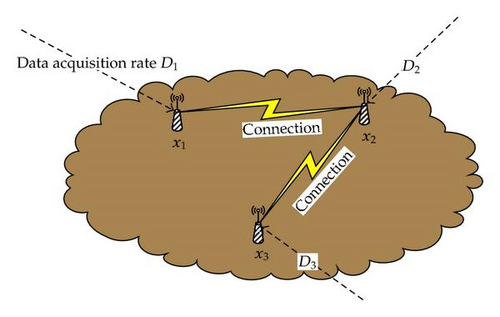
For reliability analysis, the following definitions and lemmas are introduced.
Definition 2.1. Wireless sensor network (2.3) is stochastically reliable in mean-square sense if there exists a bounded positive constant C such that for node data variable x(t, r(t)), there is
Definition 2.2. Wireless sensor network (2.3) is asymptotically reliable almost surely if there exists a bounded positive constant C such that
Lemma 2.3 (see [12].)Given any real matrices Q1, Q2, Q3 with appropriate dimensions such that , the following inequality holds:
Lemma 2.4 (Schur complement). Let X = XT ∈ ℝ(n+m)×(n+m) be a symmetric matrix given by , where A ∈ ℝn×n, B ∈ ℝm×n, C ∈ ℝm×m, and C is nonsingular, then X is positive definite if and only if C > 0 and A − BTC−1B > 0.
3. Reliability Analysis
3.1. Constant Date Acquisition Rate
Theorem 3.1 (Lasalle theorem). Consider Markovian jump system (3.4) with u*(k) ≡ u*(l), for all k, l ∈ S, and Lyapunov function V(x(t, k), t, k) satisfies that V(x(t, k), t, k) ∈ C2,1 (ℝn × ℝ+ × S; ℝ+), if there exists 𝒦∞ function W1(x(t, k)), W2(x(t, k)) and nonnegative continuous function W(x(t, k)) such that
Proof. Please refer to the appendix.
By combining Theorem 3.1 and (3.7), we have the following theorem about the stability for network (2.3) with unique equilibrium.
Theorem 3.2. Consider wireless sensor network (2.3) with constant date acquisition rate D, if there exist a series of symmetric positive definite matrices Pk, Q3k, k ∈ S such that
Proof. Since u*(k) ≡ u*(l) = u*, for all k, l ∈ S, thus (3.6) is translated to
3.2. Varying Date Acquisition Rate
In most cases, the distribution of equilibria u*(k) will differ with different network topology. Obviously this difference will bring effects on the trajectory of node state in network (2.3). For example, network regime is r(t1) = k at time point t1 and behavior of state trajectory is determined by the corresponding dynamic , t ≥ t1 such that the trajectory x(t) is going towards the desired equilibrium u*(k) with reliability criteria satisfied. After a random time Δt, a sudden event occurs and now the regime is l with new network topology described as , t ≥ t1 + Δt; thus the trajectory x(t) will going towards a new equilibrium u*(l) following the new topology. Intuitively, node state x(t) will keep going towards the corresponding equilibrium u*(j) for each regime j with reliability criteria ensured. Thus it will finally run into a region which is concerned with the distribution of all the equilibria. It is obvious that reliability criteria only guarantee the node trajectory goes towards the equilibrium and cannot explain how close it can be near the equilibrium. For quantitative analysis, we have the following theorem.
Theorem 3.3. Consider stochastic network (2.3) with switching equilibria u*(k), if there exist a series of symmetric positive-definite matrices Pk, Q3k and positive scalar ϵk such that the following inequality is ensured:
Proof. According to inequality (3.6), there is
Remark 3.4. In above analysis, we give the sufficient conditions for network (2.3) to be reliable in mean-square sense. It can be seen with (3.18) ensured, the trajectory of each regime k is sure to enter an attractive region around the equilibrium u*(k), and the radius of attractive region is an increasing function of the distance of all equilibria , and this distance reflects the intrinsic characteristic of network which is determined by network topology. In order to decrease the radius, one possible way is to increase the value of α. From (3.25), we know that α determines how fast the trajectory can converge to the attractive region, and α is concerned with node calculation capacity f, network topology G, and network status c. The larger the parameter α is, the faster the convergence speed is, and also the smaller radius is. For these reasons, we request a larger parameter α for convergence speed and convergence precision.
Remark 3.5. Neither control variable nor decision action appears in the model of network (2.3), and the above analysis reflects the natural property of autonomous network. Note that parameter C is a conservative result for the bound of node state, and the radius of attractive region for practical network will be less than C. Consider a network with performance demand that E{|x(t)|2} ≤ γ after calculating we know C ≤ γ; thus we need to do nothing and just let the network work by itself. Otherwise, there may be a need taking control or decision to change either the network topology Gk or the transition rate matrix Π for the satisfaction of performance. This work will be of some help for network topology design and decision making.
4. Numerical Example

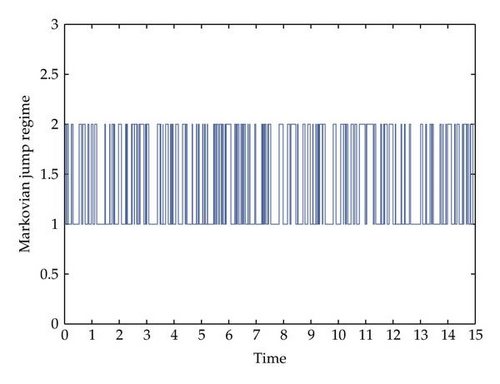
4.1. Constant Date Acquisition Rate
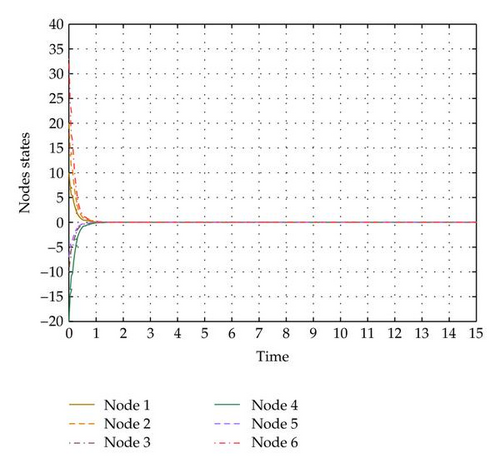
4.2. Varying Date Acquisition Rate
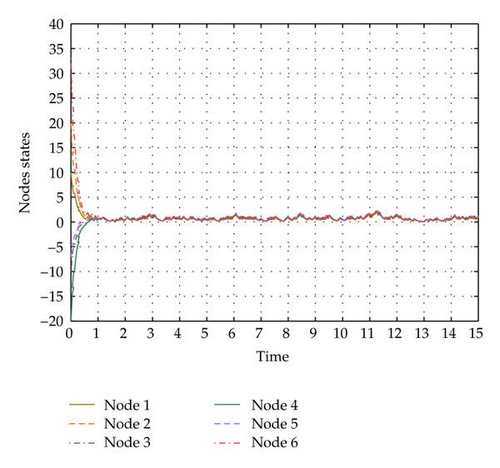
Consider network (2.3) has multiple equilibria , , i = 1, …, 6, thus D1 = [0,0, 0,0, 0,0] T, D2 = [10.9722,11.9833,12.9722,13,9944,15.0389,16.0389] T while other parameters keep unchanged as well as the Markovian jump sample. Noticing that the reliability criteria are the same as the case of , , i = 1,2, …, 6. According to Theorem 3.3, such network is also stable in mean-square sense, and its node state trajectory is shown in Figure 6.
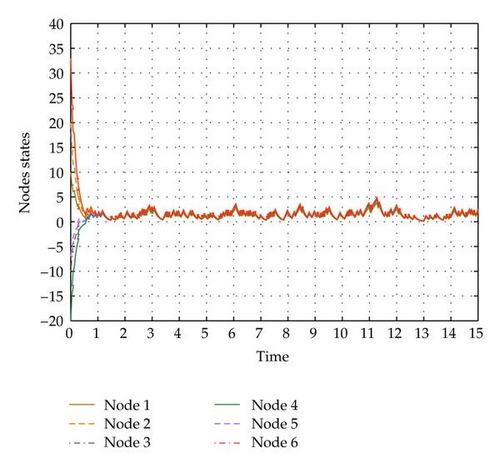
It can be seen from Figures 5 and 6 that with the same parameters P1, P2, Q31, Q32, ε1, ε2 satisfying the reliability criteria in Theorem 3.2, the node state trajectory can converge to the attractive region with the same convergence speed, which is dependent on parameter f(k), Gk, ck, N, m, Π with the same Pk, Q3k, εk, that is, this speed is determined by the natural property of network. However, the radius of this region is different: for the former case , , the radius is smaller while for the latter case , , the radius is larger, which means the radius of attractive region is an increasing function of the distance between the equilibria.
5. Conclusion
Reliability problems of stochastically switching wireless sensor network are studied in this paper. This switching, governed by Markovian chain, changes not only network topology, but also the data acquisition rate from outside environment. Our work reveals that reliability is dependent on three elements: network topology, network parameters and Markovian chain. When data acquisition rate keeps unchanged so that all network topologies share a common equilibrium despite of regime jump, network node state can be asymptotically reliable almost surely if the above three elements satisfy sufficient conditions. For varying data acquisition rate case, node state can converge to an attractive region similarly with sufficient conditions ensured, while its radius is concerned with the distribution of all the equilibria. Numerical simulations present an intuitive understanding of these relations and all the reliability criteria in this paper can be feasible for a general network.
Acknowledgments
This work is supported by the National Natural Science Foundation of China under Grant 60904021, the Fundamental Research Funds for the Central Universities under Grant WK2100060004, and National High-Tech Research and Development Program of China 863 Program under Grant 2008AA01A317.
Appendix
Lasalle Theorem in Markovian Jump Systems
Lemma A.1 (Supermartingale inequality [16]). Let ξt, t ∈ ℝ+ be a right-continuous supermartingale, there is for all s0 < t0 ∈ ℝ+, λ > 0, one has
Lemma A.2 (Fatou′s lemma). Let {fk(x)} be a series of measurable nonnegative functions defined on ℝn, one has
Now we introduce the Lasalle theorem in Markovian jump systems as follows.
Theorem A.3 (Lasalle theorem). Considering Markovian jump system of the form:
Proof. First we will prove the global stability in probability of the Markovian jump system (A.3).
By (A.4) and (A.5), we have ℒV ≤ 0 and V ≥ 0,which means V is a supermartingale on probability space (Ω, ℱ, {ℱt} t≥0, P). For any class 𝒦∞ function γ(·), with supermartingale inequality applied, there is
Next we would prove the establishment of (A.6).
We decompose the sample space into three mutually exclusive events:
-
(1) A1 = {ω : limsup t→∞ W(x(t, ω)) = 0},
-
(2) A2 = {ω : liminf t→∞W(x(t, ω)) > 0},
-
(3) A3 = {ω : liminf t→∞W(x(t, ω)) = 0 and limsup t→∞W(x(t, ω)) > 0}.
Let h = 1,2, … be a positive integer. Define the stopping time as
Now we proceed to show that P{A3} = 0 by contradiction. Suppose P{A3} > 0, then there exists ϵ > 0 such that




